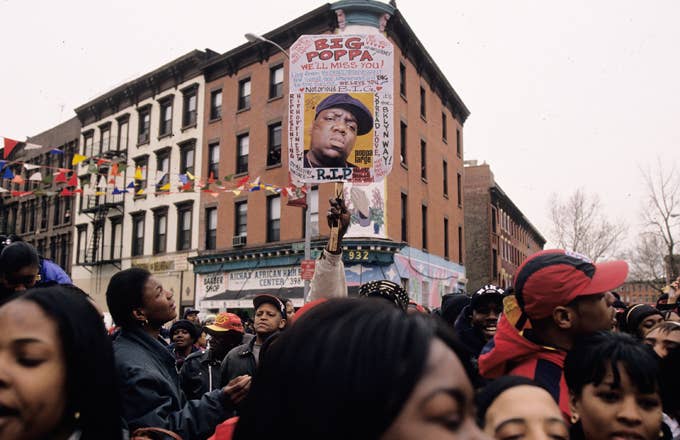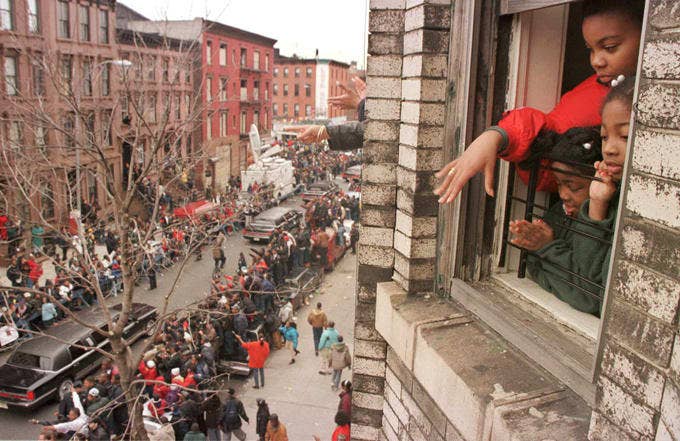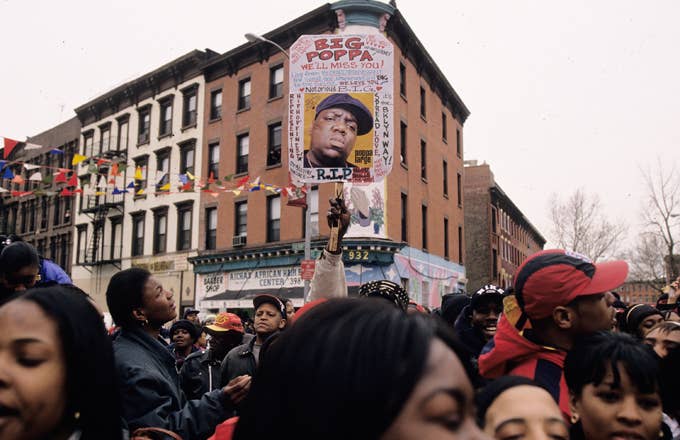
Where were you?
On March 9, Christopher George Latore Wallace—the beloved bad boy Biggie Smalls, a.k.a. the Notorious B.I.G.—was pronounced dead at 1:15 a.m. at Cedars-Sinai Medical Center in Los Angeles, of gunshots from a drive-by shooting following a Vibe magazine party. Early that Sunday morning, I rolled out of bed in the Jersey City apartment of my girlfriend to walk her terrier. (She was in L.A.) I called my answering machine to check the messages back at my own place in Brooklyn, two blocks down from 226 St. James Place where Big grew up. My heart dropped.
Dad called. My closest homeboy called. My girlfriend called, distraught with the details, from right outside the Peterson Automotive Museum where Biggie had been killed. I was 26, and had been chipping away at music journalism for three years. Big was 24 and the king of New York. An instant classic of 1990s hip-hop, Life After Death dropped two weeks later; I’d already reviewed it for the now-defunct Rap Pages magazine, in an issue sporting photographer Barron Claiborne’s legendary portrait of Biggie: crimson-tinged, golden crown cocked to the side. The memory of Tupac Shakur’s senseless murder less than seven months months prior was fresh on everyone’s spirit.
“This is the death of another of our icons; what does that mean?” Tracii McGregor, former editor at The Source, remembers wondering. “What is this violence that’s now pervading our culture? What role did we as journalists play in promoting [this]? It forced us as a community to really look closely at our roles. I know that we [at The Source] hunkered down. It changed everything for everybody.”
On March 16, McGregor, along with hundreds of other mourners, stood outside the Frank E. Campbell Funeral Chapel near East 81st Street on Madison Avenue. It was the Sunday following Biggie’s murder. “Only major celebrities and, like, Mafia cats get buried there, ’cause there’s a level of discretion,” she recalls. “[But] there were throngs of fans outside the funeral home held back by police officers. And then we all hopped the train once the procession started leaving.”
The self-righteous personality streak of my 20s in full effect, I didn’t join the thousands of boombox-carrying, placard-waving rap lovers—both young and old, overwhelmingly black and brown—logging the streets of St. James Place that afternoon. In a basement garden apartment two streets away on Grand Avenue, I stayed in bed. I’d seen Big perform at a Howard University homecoming (“May see me in D.C. at Howard Homecoming,” he spat on “Kick in the Door”), again at a Vibe anniversary party, and once walking down 23rd Street near the Tunnel nightclub with Faith Evans—an afterparty for the Source Awards. But we never met. I pictured it like ambulance chasing, standing out in the freezing cold waiting for his hearse to roll down the street. I was wrong. Turns out it wasn’t morbid or opportunistic at all; it was a celebration.

“I was en route somewhere at the time,” recalls celebrated graf artist Chino BYI. “This is before social media. There were no mass email blasts. But sort of like when school lets out at 3:00 and there’s gonna be a fight? You follow the energy and the people in the direction of where it’s about to go down. There were people gravitating towards Fulton Street towards Washington Ave. And I became one of those people making their way down there. I remember the closer I got, there was this massive sea of people out there. I was a huge fan. I had met Big officially through Matty C at The Source a handful of years back. I actually had Big’s [Ready to Die] demo. I still have it.”
My gut made me venture outdoors, specifically my stomach. (Pillsbury cookie dough was a personal vice.) Around lunchtime I hit the Key Food supermarket on Fulton Street, around the corner from St. James Place. (Even before his death, the store hung a framed photo of our local hero on the wall, right past the cash registers.) Moving through the sidewalks wasn’t easy; I took to the street. The multitude of folks made up a living, breathing memorial shrine: candles, flowers, cardboard signs, B.I.G. T-shirts for sale. I spotted fellow hip-hop scribes who’d loved, met, and written of Biggie the past three years: YSB magazine editor Tonya Pendleton; Vibe’s Karen Good Marable; Cheo Hodari Coker, eventual Luke Cage showrunner and the co-writer of the Notorious biopic; XXL’s Rob Marriott. Everyone watching, waiting, anticipating. I ducked back inside, firing up my oven and Tricky’s Nearly God album.
There were the TV camera trucks too. “It started off very quiet, very peaceful,” remembers Abbie Kearse, then a producer-reporter for MTV. “Slowly people were gathering, waiting, and talking. It was a mellow mood. There wasn’t really much going on other than people just waiting, not knowing exactly what to expect. There was a large police presence right up the street from where I was standing.”
And then, at 2:10, the motorcade arrived: eight stretch limousines and about 30 flowered cars according to the New York Times. Turning onto St. James Place towards Fulton Ave, a JFK-worthy cavalcade of mourners—mother Voletta Wallace, Sean Combs, Faith Evans, Junior M.A.F.I.A.’s Lil’ Cease, D-Roc, Lil Kim, and more—accompanied the Notorious B.I.G. in his final touchdown to Planet Brooklyn.
“That’s when the joy, the ebullience, kinda filled the streets,” Tracii McGregor recalls, of the moment when “Hypnotize” blared from the Underground nightclub’s speakers on Fulton. “The music. That’s when folk started to connect. It became a party, it became what I imagine he would’ve wanted. It was a beautiful moment, people just losing their minds. It was emotional.”
Chino BYI says, “Everyone who was home at the time was probably hanging out of their windows. There were people standing on cars, on fire escapes. I could see people on rooftops. People had climbed up traffic poles. I remember seeing people crying in the streets, consoling each other. There was this shared, collective somberness that I don’t think I had ever experienced growing up in New York City before. It was this moving, public display of emotion, and that was touching.”
Abbie Kearse: “It was joy. It was celebration. The adrenaline had risen and it was a positive energy.” But soon after the motorcade passed, the tide turned. “It was literally seconds from the time that the procession passed through where things started to sort of erupt. You could see the aftermath of a person being sprayed with pepper spray and asking for water for their eyes.”
Because after “Hypnotize” galvanized the crowd into dancing, shouting, and other fitful bursts of exaltation, the police got antsy. The hearse took its leave only five minutes earlier, but cops wanted near immediate dispersal. A few heated words led to pepper spray from the police and the separation of everyone assembled.

Hungry for spectacle, the New York Times led with “On Rap Star’s Final Ride, Homage Is Marred by a Scuffle.” Tracii McGregor doesn’t recall it that way (“I hate that that has to be the memory the media has to put forth, because honestly, that’s not the majority of what happened there that day”), but the since-deceased New York Times reporter Julia Campbell was arrested and charged with disorderly conduct along with nine others. As long and strong as the memorial lasted, the streets of Clinton Hill were completely cleared 15 minutes after Biggie’s pass-through.
My own suffering in silence sprung from the shock of it all more than anything else. Big and Tupac were two of the most talented, charismatic MCs of the time; were Snoop Dogg, Sean Combs or any other rappers any safer? Blaring Alison Moyet’s “Make a Change” from my small, Purple Rain-ish basement apartment, I mourned Biggie in private over Chocolate Thai and chocolate chip cookies. That day, he belonged to Brooklyn, belonged to us all.
For more on the Notorious B.I.G. and the 20th anniversary of his tragic death, click here.


